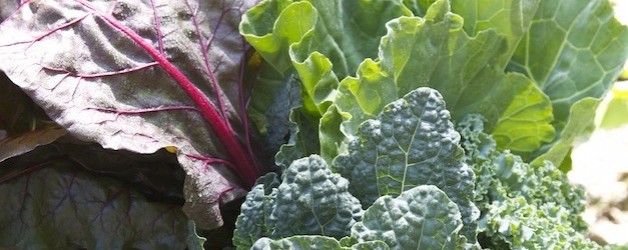

A few weeks ago, we wrote about Super Foods, all those extraordinary ingredients out there that are packed with heart- and brain-healthy nutrients. Dark, leafy greens like kale, collard greens, and Swiss chard easily make it into the Super Foods category and are among the most nutrient dense foods available. If you didn’t grow up eating these greens, you may have no idea what to do with them, or you may just be tired of only eating kale in chip form (a preparation that has been popular lately). Here are some ideas on how to work these beneficial leafy greens into your weekly meal planning.
How to Buy
- With any of these greens – kale, Swiss chard, collard, mustard, or turnip – look for dark green leaves that are firm without any yellowing or bruised spots, and crisp stems.
- Kale: Two main varieties that are easy to find are curly and dinosaur (sometimes called Tuscan, Lacinato, or cavolo nero). The latter has longer, narrow leaves that are crinkly. The dinosaur kale has a sweeter flavor and is great eaten raw (think of adding to salads). With any kale variety, smaller leaves with narrower stems and ribs will be younger, and therefore more tender and mild tasting.
- Swiss chard: The leaves of Swiss chard can be quite stunning since the stems and ribs can be deep reds, yellows, or white. They look as good on the plate as they are to eat. They are related to beets and spinach, so the flavors are similar.
How to Store
- Swiss chard should be lightly rinsed, wrapped in moistened paper towels, then stored in the refrigerator in a plastic bag.
- Other greens can be stored unwashed in a plastic bag in the refrigerator.
- Heartier greens like collard, turnip, and mustard will keep up to five days in the refrigerator, while Swiss chard and kale will keep two to three days.
- Super Greens can also be cleaned, cut, blanched, and frozen. See inspiration365 post for instructions (link).
Preparation Tips and Ideas
- The stems on most leafy green are edible as well, except for the thicker, tougher stems on more mature leaves. If the stems are narrow and tender you can usually just cut up the stems along with the leaves. If, however, you need to remove the stems, use a sharp knife to cut along either side of the stem. Another way to remove the stem is to hold one end of the stem in one hand while you strip away the leaf from the stem with the other hand. Simply run your fingers along the stem.
- To cut leaves into “ribbons,” stack the leaves together, then roll them up and cut thin strips cross-wise. These can be sautéed, steamed, or added to soups, stews, omelets, or frittatas.
Recipe for Swiss Chard: Sautéed Swiss Chard with Pancetta or Bacon
From Kimberly’s kitchen: This is a delicious, fast way to prepare Swiss chard. The recipe was passed on to me by my mom years ago so I don’t know where it came from, but I have been using it ever since.
- 3 tablespoons extra-virgin olive oil
- ½ cup (2 ounces) chopped pancetta
- 2 garlic cloves, thinly sliced
- 2 fresh chiles, like Fresno or jalapeno, finely chopped (optional)
- 2 pounds Swiss chard, leaves whole, stems and ribs removed and chopped
- ½ teaspoon freshly ground black pepper
Heat oil in a large pot over medium-high heat. Cook pancetta, stirring, until crispy, about 3 minutes. Add garlic, chiles, and chard stems and ribs and cook until slightly softened, about 4 minutes. Add chard leaves and pepper, cover pot, and cook until wilted, stirring occasionally, about 6 minutes.
Recipe for Kale: Kale Chips
- Kale (1 bunch per baking sheet)
- Olive Oil (1 tablespoon per bunch of kale)
- Kosher Salt
1. Wash and prepare kale leaves (clean, cut out stems, cut leaves into large pieces).
2. Once the kale is prepped and the pieces are dried off (to dry, spread on a kitchen towel or use a salad spinner), toss them in a bowl with the olive oil.
3. Spread the kale pieces on a baking sheet (cover in parchment paper for non-stick and easy clean up).
4. Sprinkle with Kosher salt and bake at 375 degrees for 20 minutes total (stir the leaves after about 10 minutes for even baking). Depending on the kale, the leaves may turn sort of black. That’s okay — it’s still delicious!
Kale and White Bean Soup http://www.epicurious.com/recipes/food/views/Kale-and-White-Bean-Soup-106153
